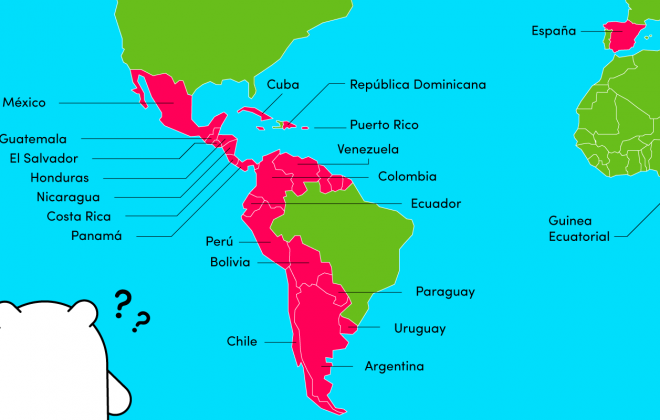If you’re (enter mood) and you know it, watch…
When it comes to learning a language, there are a myriad of resources one can choose from to add authenticity to the experience: from travelling to the countries where the language is spoken to finding a tandem partner or listening to music in the target language. However, if you don’t happen to have a couple of thousand euros laying around, or you can’t ever seem to find the time to meet your tandem partner, or music alone doesn’t feel enough to experience the culture in a holistic way, then I have the answer for you: watching movies.
As a movie buff I can tell you: movies in Spanish are the best! This statement might be a bit biased, since I’m a Spanish native speaker, but let me show you how varied and wonderful Spanish-language movies are. There are 20 Spanish-speaking countries and with that comes a variety of accents, landscapes, traditions and expressions. That’s the beauty of it! So finding movies that explore wide ranging themes in a variety of settings is a walk in the park.
Let me walk you through a list of my favourite movies that each have something suitable for all tastes and moods:
If you feel like…
…learning colloquial language
and you want to learn how to chamuyar* like a professional, then you should watch this Argentinian movie: Nueve Reinas (Fabián Bielinsky, 2000).
Marcos and Juan meet at a convenience store where Juan is trying to con the cashier, who is beginning to see through the ruse, so Marcos sweeps in and saves him from being discovered. After this scene, they realize they have something in common: they are both con artists. So they decide to embark in a common scam: selling some original stamps to a Spanish businessman. They suffer through an endless set of problems and plot twists and in the end both con man are defeated by the Argentinian economy.
This movie will provide you with an original insight of a part of Latin America’s society you usually don’t hear about: the art of scamming. You will accompany two very charismatic characters throughout their daily conning routine and learn a lot of concepts that might be unfamiliar to you. It’s a superb and well-rounded movie. Be ready to be amazed!
But beware: don’t try this at home 🙂 .
…going on an adventure
and getting to know one of the busiest and most important markets in Asunción, Paraguay, you should definitely watch 7 cajas (Juan Carlos Maneglia, Tana Schémbori, 2012).
This movie is a masterpiece! It tells the story of Victor and his desire to be eternalized through a cellphone videocamera, which leads him down a dark path through dangerous and absurd situations in the infinite passages of one of Asuncion’s biggest markets: Mercado 4.
In one day of Victor’s life, you are confronted with misery and greed, but also with love and companionship and the cultures that make up Paraguay’s language landscape: Spanish and Guaraní.
Don’t think that your Spanish is not good enough just because all of a sudden you cannot understand something the characters are saying; they are speaking “yopará”, a mixture between Spanish and Guaraní, which is unique to Paraguay. Not only will the story fascinate you, but you will find yourself utterly invested in trying to understand how “yopará” works, and which words have been mixed together.
…hearing Spanish at a gentle/slower pace
and seeing breathtaking images, Roma (Alfonso Cuarón, 2018) is a beautifully made black and white movie. The dialogue is not in the foreground, but the images and the story they tell the audience. This movie shows a very common practice in Latin America: household staff taking care of other people’s children as if they were their own. Even if the two women in the household have their own problems (which are not insignificant, I might add), they are completely invested in the family they work for.
This Mexican movie will transport you to another time and place and you will find yourself on a journey with Cleo, one of the most empathetic and tender characters you will ever meet.
…seeing as much of Latin America as possible
and learning of its troubled history. Diarios de motocicleta (Walter Salles, 2004) tells the story of the famous Ernesto “Che” Guevara and his friend, Alberto Granado. The action begins in 1952 when they decide to embark upon an adventure and travel through South America. This experience changes their lives forever, because they will not only discover the continent’s unbelievably beautiful landscapes but also the injustices its people have to face.
So if you feel like discovering the South American continent, its hidden beauties, but also understanding why its history unfolded the way it did, then this should definitely be on your “to-watch-list”.
…seeing some telenovela-like acting.
Mujeres al borde de un ataque de nervios (Pedro Almodóvar, 1988) is one of the finest pieces of the Spanish director .
Pepa (Carmen Maura) is having an affair with Ivan, who was married to Lucia who went crazy when she gave birth to Carlos (Antonio Banderas). Ivan leaves Pepa, but she has very important news to share with him and looks for him everywhere. Carlos is looking for an apartment with his girlfriend Marisa and they end up in Pepa’s apartment. Meanwhile Candela, a friend of Pepa’s, hides in her apartment because she was involved in a terrorist attack and wants to destroy all the evidence.
This is all happening at the same time: stories get confused, the characters are desperate in the name of love and revenge and police officers get drugged. On top of that, the aesthetics of the movie plays an important role: bright colors, exaggerated forms and decoration. All very 80s.
…learning about family relations
and immersing yourself in a timeless love story, then El hijo de la novia (Juan José Campanella, 2001) is your cup of tea.
At 40-years old, Rafael Belvedere is divorced, lonely and on the verge of collapse due to stress, following the inheritance of his father’s restaurant. Overwhelmed by the demands of the restaurant, he doesn’t find the time to pay much attention to his girlfriend or daughter and he hasn’t visited his mother for a long time, who suffers from Alzheimer’s and is in a nursing home. On top of everything, his father wants to finally marry his mother, even though she’s ill and probably won’t remember anything after. It seems like a crazy idea, but when you hear the father’s monologue about why he wants to get married, you’ll have no doubt he’s doing exactly the right thing.
So if you want to believe in the endurance of love again, with a touch of Argentinian humour, make sure you watch this movie.
…having your mind blown.
This Spanish psychological thriller, Abre los ojos (Alejandro Amenábar, 1997) will walk you through the deepest fears and insecurities of César, a handsome and popular young man who likes women very much but who’s afraid of commitment. However, at his birthday party he falls in love with Sofía (Penélope Cruz), the date of his best friend, Pelayo. Nuria, a former lover of César, moved by jealousy, causes a car accident that proves fatal for her, and leaves Cesar’s face completely disfigured. From that moment on his life changes completely, turning into a horrible nightmare.
The twists and turns this movie takes will make you doubt your own sanity.
…watching an extremely romantic love story.
The Spanish cult film, Los amantes del círculo polar (Julio Médem, 1998) is full of coincidences: Ana and Otto meeting, both their names being palindromic, their parents falling in love, them meeting after many years on the other side of the world…
The story of the film is composed of a circular plot in which the two characters cross their lives in parallel and develops from the moment in which Otto and Ana meet by chance, when he goes after a ball, while Ana is running away from her mother because she just learnt about her father’s death.
The movie is full of symbolism and beautiful scenes, where words are used very wisely and intently.
…learning about superstitions
and a very important episode in Peru’s history.
The story of La teta asustada (Claudia Llosa, 2009) focuses on Fausta, a young woman who, according to her beliefs, suffers from a strange fictitious disease called “la teta asustada**”, which transmits fear and suffering from mothers to children through breast milk, as her progenitor endured violence during the period of terrorism in Peru.
This Peruvian movie won the Golden Bear -best movie- at the Berlin International Film Festival and was nominated for the Oscars in the category Best Foreign Language Film.
One of the achievements of this film is that it shows the impact of an era of extreme violence in Peru that not many know about, which is why its international recognition is so important.
I hope you’ve found at least a couple of movies you’d be interested in watching and stay tuned, because there will be definitely a second post with more movie recommendations!
¡Disfruta de tu película!

*chamuyar: sweet-talk, specially when you’re trying to trick them
**la teta asustada: the frightened breast
Want to learn more?
If you’re feeling inspired, sign up below for a free two-week trial and a Live Lesson with a private qualified tutor to start speaking a new language for real! Our classes are structured around exercises created by language teachers, so there’ll be no awkward silences – we promise! 😉
And don’t forget to check out our Facebook, Twitter and Instagram pages for more language content!



